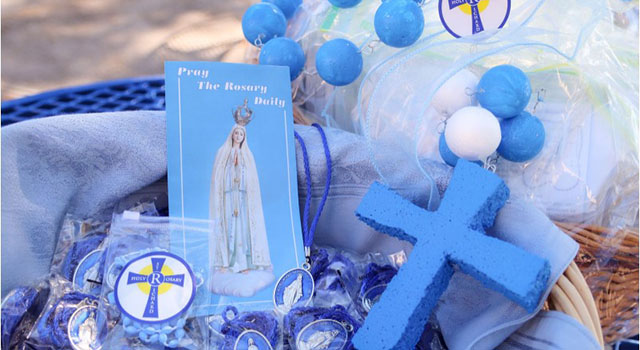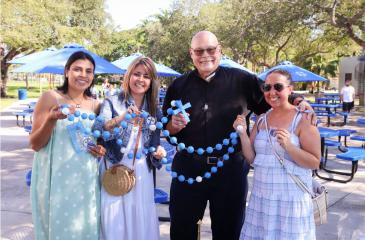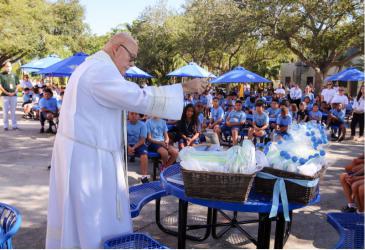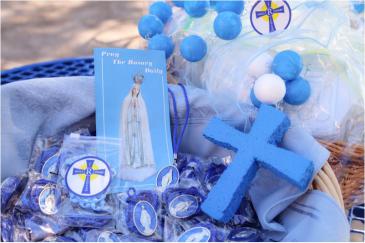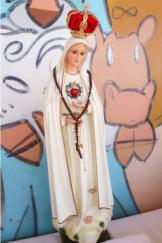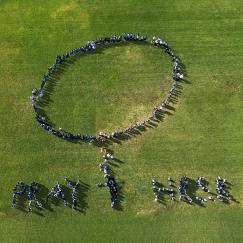By Jim Davis - Florida Catholic
Photography: COURTESY
MIAMI | The “Poor Man’s Breviary,” it’s been called. But a better nickname for the rosary might be “the Bible on a string.”
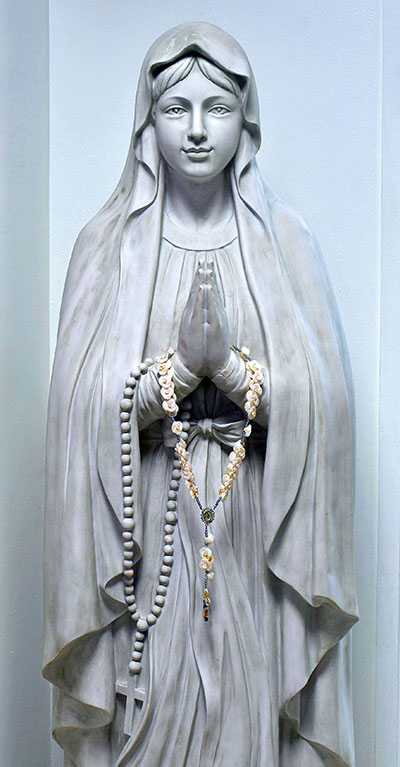
Photographer: James Dwight Davis
A sweet-faced statue of Our Lady of Lourdes greets visitors to St. Boniface Church, Pembroke Pines. She holds a rosary, as St. Bernadette saw her. Someone has also placed another rosary in her hands.
For millions, the rosary is the heart of personal devotion. Those 59 beads retell the lives of Jesus and Mary, illuminating their special relationship to each other – and to us.
In appearance, the rosary is a necklace of beads – wood, glass, crystal or other materials – with a cross as a pendant. But its name is drawn from the Latin word rosarium, or “rose garden,” an old term for a collection of literary works.
The rosary does hold a library of several important Church prayers including:
- The Apostles’ Creed, summarizing foundational Christian beliefs in the triune God, the virgin birth, the death and resurrection of Jesus, and his return.
- The Our Father, or the Lord’s Prayer, voicing faith in God, his daily provision and his lordship over the universe.
- The Doxology, glorifying the Father, Son and Holy Spirit.
- Salve Regina, an anthem to the “Holy Queen, mother of mercy.”
The prayers include five decades, or 10 recitations each, of the Hail Mary prayer, with the Lord’s Prayer before each and the Doxology afterward.
The rosary also calls Catholics to meditate on several “mysteries,” or events from the lives of Jesus and Mary. Since medieval times, they have fit into three groups:
- Joyful mysteries, including the annunciation of Gabriel that Mary would bear Jesus; her visit to Elizabeth to share the news; the Nativity of Jesus; his presentation in the Temple as a baby; and the day Mary found him in the Temple as a boy, teaching religious elders.
- Sorrowful mysteries, including Jesus’ agony in the garden, awaiting his arrest; his scourging at the hands of soldiers; his crowning with thorns; his carrying the cross, and his death.
- Glorious mysteries, including Jesus’ resurrection and ascension; Pentecost, when the Holy Spirit descended onto his disciples; the Assumption of Mary, being taken bodily into heaven; and her coronation as queen of heaven.
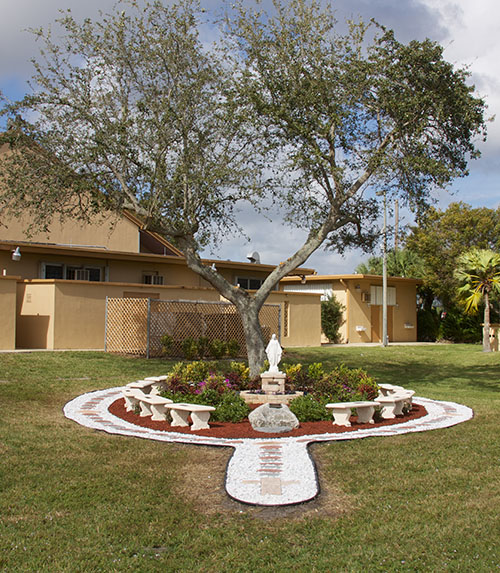
Photographer: JONATHAN MARTINEZ | FC
The Rosary Garden at St. Bernadette Church in Hollywood was an Eagle Scout project completed in 2014.
In 2002, St. Pope John Paul II made a historic addition: the luminous mysteries. They include Jesus’ baptism; his first miracle, turning water into wine at a wedding feast; his proclamation of the Kingdom of God; his transfiguration before his three top disciples, and his institution of the Eucharist.
During the recitations, Catholics are asked to reflect on the mysteries, gain a deeper appreciation for their truths, and consider how they can live the faith more authentically.
Since 1917, many Catholics also have added a prayer after each decade for the conversion of souls. That was a request of the apparitions of Mary at Fatima, Portugal, who announced herself as “the Lady of the Rosary.”
As familiar as the rosary has become, its origins are lost in history. A popular tradition says that an apparition of Mary gave it to the 14th century St. Dominic. He then used it as a tool of evangelization, especially to counter the Albigensian heresy of the time.
However, even in the early days of the Church, monks were using cords with knots or beads to help them count recitations of prayers such as the Our Father and Hail Mary. Eastern Orthodox Christians use cords with up to 300 knots or beads. Anglicans, Muslims, Buddhists and Hindus use their own versions of prayer beads as well.
Before the printing press was invented, most people couldn't pray from the Church’s Psalter, or book of psalms. So they began praying 150 Our Fathers or Hail Marys in place of the 150 psalms. To keep count, they began stringing beads together.
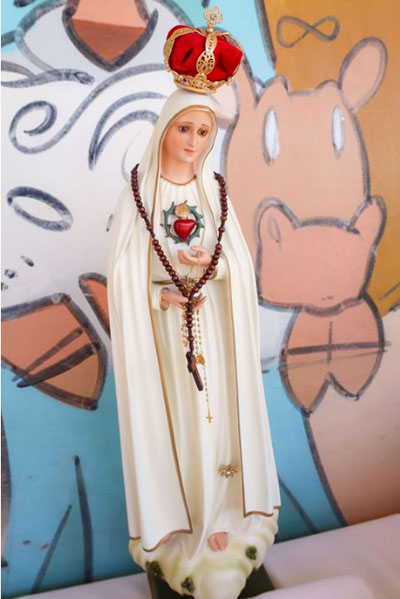
Photographer: COURTESY
Students at Our Lady of the Holy Rosary-St. Richard School placed flowers in front of this image of Our Lady of the Holy Rosary to mark the feast of the Holy Rosary, Oct. 7, 2022.
Dominic the Carthusian, in the 15th century, promoted a series of 50 Hail Marys and 50 Vita Christi clauses (references to the life of Christ). Also in the 15th century, Alanus de Rupe founded a brotherhood to spread the practice of rosary prayer.
Pope Pius V gave the devotions a big boost in 1571. He called for Catholics to pray the rosary before a battle between Christian and Turkish Muslim navies. Called the Battle of Lepanto, the conflict dealt defeat to the Muslims and safeguarded European Christendom. A grateful Pius declared October 7, the day of the battle, the feast of Our Lady of the Rosary.
Nowadays, all of October is regarded as the Month of the Holy Rosary, and nearly all popes have strongly recommended praying it.
“I invite you to pray the rosary, and to carry it in your hands or in your pockets,” Pope Francis has said. “The recitation of the rosary is the most beautiful prayer we can offer to the Virgin Mary … and is a weapon that protects us from evils and temptations.”
For those who want to learn to pray the rosary, the United States Conference of Catholic Bishops offers a handy, step-by-step online guide. So does the New Advent website, as a downloadable .pdf.
Some places even put some action into the rosary, creating walking paths that recall rosary beads. One of the best-known in Florida is at the National Shrine of Mary, Queen of the Universe in Orlando. Another is at the school at Our Lady of the Lakes, Miami Lakes. And Emmanuel Church in Delray Beach has rimmed its pond with globe lamps, turning a footpath into a Rosary Walk.
However it’s done, praying the rosary can have a mystical effect, evoking a mental and emotional pilgrimage through the Gospel.
“After meditating on each mystery, they become less like stories you’ve read aloud in a church and more like places you’ve visited in a dream,” wrote author Anna Keating in Spirituality & Health. “They're a part of you.”
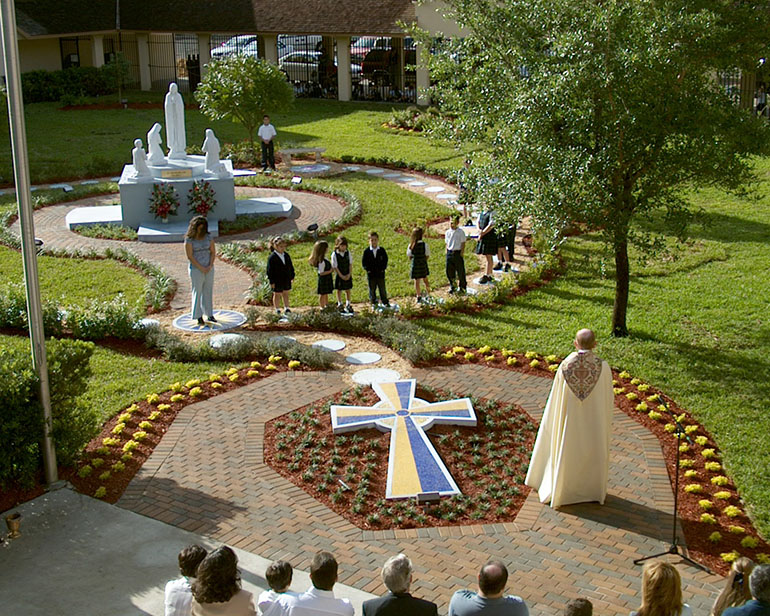
Photographer: FILE
A rosary garden, donated by a parish family and completed in 2004, anchors the courtyard at Our Lady of the Lakes School in Miami Lakes.
